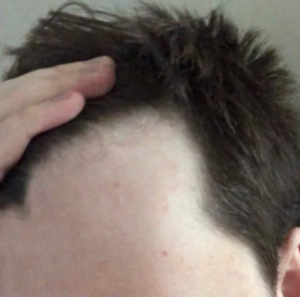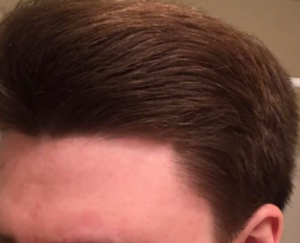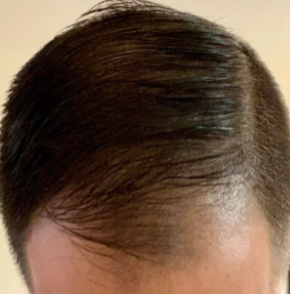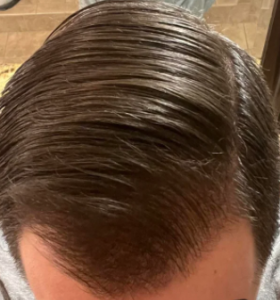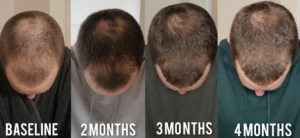I’m 45 yo and frontal loss has me kinda upset. I know I’m lucky I’ve had plenty of hair up to this point and am wondering if I’m just being vain trying to improve my hairline at this age? For some reason, I can’t deal with the idea of going bald and looking older. I am planning on starting Fin every other day and see what happens. But I wonder if I’m just being dumb about this. I want decent hair for the rest of my life tho. I’d even consider a HT someday while staying on the eod Fin. I want to be one of those good looking older men who can still get chicks if desired. Stupid and vain right ?
If you are not satisfied with your hairline, then consider a hair transplant as it would be unlikely that finasteride will reverse it; however, if you are losing hair than finasteride is a good drug to address that even at your age.
I can’t tolerate finasteride or even topical finasteride. So I got a hair transplant and now found that I lost a lot of hair from shock loss within the past month.
You were in a difficult place and I appreciate the problem. The price of shock loss vs the price of loss of your sex life. I wouldn’t give up my sex life for hair. The good news is that after the first shock loss, it is unlikely to happen a second time if you follow up with a second hair transplant down the road in the next couple of years.
An Old Medicine Grows New Hair for Pennies a Day, Doctors Say
Dermatologists who specialize in hair loss say that the key ingredient in a topical treatment worked even better when taken orally at a low dose.

By Gina Kolata
The ads are everywhere — and so are the inflated claims: Special shampoos and treatments, sometimes costing thousands of dollars, will make hair grow. But many dermatologists who specialize in hair loss say that most of these products don’t work.
“There is an endless array of useless hair growth remedies,” often at “significant cost,” said Dr. Brett King, a dermatologist at Yale School of Medicine. Yet, he added, “because people are desperate, such hair growth remedies continue to abound.”
But there is a cheap treatment, he and other dermatologists say, costing pennies a day, that restores hair in many patients. It is minoxidil, an old and well-known hair-loss treatment drug used in a very different way. Rather than being applied directly to the scalp, it is being prescribed in very low-dose pills.
Although a growing group of dermatologists is offering low-dose minoxidil pills, the treatment remains relatively unknown to most patients and many doctors. It has not been approved by the Food and Drug Administration for this purpose and so is prescribed off-label — a common practice in dermatology.
“I call us the off-label bandits — a title I am proud to bear,” said Dr. Adam Friedman, professor and chair of dermatology at George Washington University. He explained that dermatologists have been trained to understand how medicines work, which allows them to try drugs off-label. In dermatology, it is often clear if a treatment is helping. Does a rash fade, or not?
Dr. Robert Swerlick, professor and chair of the dermatology department at Emory University School of Medicine, agreed.
- Did you know you can share 10 gift articles a month, even with nonsubscribers?
“I tell people most things we do are off-label because there is nothing on-label,” he said. He provided a long list of conditions, including skin pigment disorders, skin inflammatory disorders and relentless itching, for which the standard treatments are off-label.
Minoxidil, the active ingredient in Rogaine, a lotion or foam that is rubbed on the scalp, was first approved for men in 1988, then women in 1992, and it is now generic. The medicine’s use as a hair-growth treatment was discovered by accident decades ago. High-dose minoxidil pills were being used to treat high blood pressure, but patients often noticed that the pills prompted hair growth all over their bodies. So its manufacturer developed a minoxidil lotion — eventually named Rogaine — and got it approved to grow hair on balding heads.
But dermatologists say the lotion or foam is not particularly effective for some patients, perhaps because they stop taking it. It has to get on the scalp itself — and hair gets in the way. Many, especially women, stop using it because they dislike leaving the sticky substance in their hair.
Johnson and Johnson, the current owner of Rogaine, did not respond to requests for comment.
Others find it simply does not work for them. Minoxidil has to be converted to an active form by sulfotransferase enzymes that may or may not be present in sufficient quantities in hair roots. When the drug is taken orally, it is automatically converted to an active form.
But that was not the reason the low-dose pills were discovered. Instead, the discovery occurred also by accident 20 years ago.
Dr. Rodney Sinclair, a professor of dermatology at the University of Melbourne in Australia, had a patient with female pattern baldness. The hair on top of her head had thinned, and she hated the way it looked. Unlike what happened with most of his patients, Rogaine worked for her, but she developed an allergic rash on her scalp from the drug. Yet if she stopped taking it, her hair would thin again.
“So I was stuck,” Dr. Sinclair said. “The patient was very motivated, and the one thing we knew was that if a patient has an allergy to a topically applied medicine, one way to desensitize is to give very low doses orally.”
To do that, Dr. Sinclair tried cutting minoxidil pills into quarters. To his surprise, the low dose made her hair grow but did not affect her blood pressure, the original purpose of the higher-dose drug.
He subsequently lowered the dose more and more until he got down to effective doses of one-fortieth of a pill and began routinely prescribing the drug. That first patient still takes it.
At a meeting in Miami in 2015, Dr. Sinclair reported that low doses of minoxidil prompted hair growth in 100 successive women.
He published those results in 2017, noting that rigorous studies were needed, in which some patients would be randomly assigned to take minoxidil and others a sugar pill. But that has not happened. He says he has now treated more than 10,000 patients.
Recently, a rising number of hair-loss dermatologists have been giving the low-dose pills to patients with male and female pattern hair loss, a normal occurrence with age.
Image

“It is just starting to see a surge in popularity,” said Dr. Crystal Aguh, a dermatologist at Johns Hopkins School of Medicine. “More and more at conferences, we are sharing our success stories.”
Doctors who do not specialize in hair loss, she added, “would not be familiar with oral minoxidil,” except as a rarely used treatment for high blood pressure that comes with a black box warning that it can cause heart problems. But, she and others say, the warning is for much higher doses.
If hair loss is too severe, minoxidil will not help, Dr. Aguh warned. “It will not work, for example, if a man is mostly bald, with a shiny scalp. There is nothing to restore.” She added that the ideal patient is not completely bald but has lost enough hair that even a casual observer would notice.
Without a rigorous trial leading to F.D.A. approval, though, the use of minoxidil pills for hair loss remains off-label. And, dermatologists say, it is likely to remain so.
“Oral minoxidil costs pennies a day,” Dr. King said. “There is no incentive to spend tens of millions of dollars to test it in a clinical trial. That study truly is never, ever going to be done.”
Some patients taking low-dose minoxidil, though, notice stray hairs growing on their faces and chins. So some dermatologists, including Dr. Sinclair, have added another drug — very low doses of spironolactone, a blood pressure drug that also blocks certain sex hormones called androgens — to try to prevent unwanted hair growth.
Patients who do not want to go the off-label route are left with what some dermatologists say are useless over-the-counter remedies or one of two F.D.A.-approved products for hair growth.
They include Rogaine and finasteride, a generic medicine used at higher doses in men to treat a benign enlarged prostate. As a hair-loss drug, it is approved for men only. It has also been linked to sexual dysfunction.
Then, there is the word of mouth about minoxidil in pill form.
“I’ve seen miracles happen,” Dr. Aguh said.
One involved Brandy Gray, 44, who lives in Monkton, Md.
“I had been losing my hair over time,” she said. “Then I starting having circular patches” with no hair. “They got worse and worse.”
She had seen another dermatologist who gave her shampoos and supplements, to no avail. Finally, she said her dermatologist told her, “There is nothing left I can try for you, nothing more I can do.”
She went to Dr. Aguh who gave her low-dose minoxidil. Ten months later, her hair was thick and abundant.
“I can part my hair in different ways,” she said. “I don’t wear wigs any more.”
It is as though that hair loss never happened.
Gina Kolata writes about science and medicine. She has twice been a Pulitzer Prize finalist and is the author of six books, including “Mercies in Disguise: A Story of Hope, a Family’s Genetic Destiny, and The Science That Saved Them.”
Hey, I’m 18 years and I want to reduce the height of my forehead. Never had hair loss, Do you guys think I can use a hair transplant to move the hairline to the blue line or I’ll have to do forehead reduction surgery?
Absolutely, do not do this because if you develop male patterned balding, then you will have created problems for yourself depending upon which solution you took. Both a forehead advancement surgery and a hair transplant lowering surgery are not indicated in an 18 year old male. The forehead advancement surgery is not a surgery for men.
Is it true that once a hair miniaturizes 50% in diameter, it can no longer be saved by potential treatment?
I don’t know that 50% miniaturization can’t be reversed. I suspect that there is some degree of miniaturization that can’t be reversed but I would suspect it is in the 80-90% range.
Royals can have them. Presidents Biden had one, Donald Trump and at least one, Chuck Shumer had one. and many presidents of countries and prime ministers have had them. If they were done prior to 1993, then it was the old technique that produced plugs and a ‘doll head appearance’. Unfortunately Biden and Trumps original surgery did not work out well as their original surgery was prior to 1993, but both found a way to fix the problem. I believe Biden had them surgical repaired with the techniques I defined in my publications, but Trump, I believe, went the hair system route. Trump would have to maintain that particularly unique and very expensive system every two week for the rest of his life.
Logically, the liposomal topical finasteride will only work in the area it is applied, while the oral covers the entire scalp. Just because you may now only have frontal or crown balding, don’t be fooled as the early miniaturization may be all over your scalp including some of the area you do not recognize, The miniaturization elsewhere on your scalp will be less than 50% of the hairy areas but many of these areas will progress to balding unless, of course, you are taking and can tolerate the oral finasteride which definitely slows of stops the progression in many men. Look at this important post: https://baldingblog.com/need-master-plan-think-hair-transplants-photos/
Dr. Dow Stough just published an important article defining the long term risks associated with getting a hair transplant. I always stress the personalized master plan for every patient, laying out a worst-case scenario. Dr. Stough nailed this subject nicely.
Original Article
The Progressive Loss Risk Scale for Hair
Restoration Surgery
Dow B. Stough, MD, CPI*†
BACKGROUND Limited information exists on the long-term risks to individuals undergoing procedures in hair restoration
surgery. The short-term risks are well known and similar to other procedures in dermatologic surgery. The long-term risks
of hair restoration surgery are seldom discussed between the physician and patient.
OBJECTIVE The author sought to describe a classification system that can be used as a communication tool between
physicians and patients to define the long-term risk involved with hair restoration surgery.
METHODS The Progressive Loss (PL) Scale is an attempt at assessing the cosmesis because of future hair loss following
a hair transplant procedure. The PL Risk Scale has designated 5 levels, 1 to 5, with each ascending level representing a
higher level of risk. The PL Risk Scale can be assigned to an individual at the time of the assessment for hair restoration
surgery.
RESULTS Each patient can be assigned a risk level based on how future hair loss may affect the overall cosmetic result of
their hair transplant. This risk is dependent on age, and specific for the area to be transplanted. The younger the age of the
patient, the higher the risk. The larger the area to be transplanted, the higher the risk. It is not a static scale, because it will
be affected by age, donor area, location of transplantation, and other mitigating factors.
CONCLUSION Pattern baldness in men and women is progressive and unrelenting. The dichotomy of hair restoration
surgery is that a satisfactory short-term outcome can evolve to disappointing results because of progressive hair loss. The
PL Risk Scale can be assigned to every individual undergoing a hair restoration procedure. This scale assignment will
convey to the patient their lifetime risk associated with any given surgical hair restoration procedure for that age and the
specific area to be restored.
DERMATOLOGIC SURGERY • July 2022 • Volume 48 • Number 7
I have written about this before. read the follow post: https://baldingblog.com/22-year-old-received-a-hair-transplant-of-2800-grafts-from-reddit/
Dr Rassman has already posted many times links to his articles about the creatine. If you want another anecdote, then I can tell you that my hair loss got drastically worse while on creatine.
I’m a man and I have a naturally high forehead and never had hair loss since I’m only 18 years old, do I have a better option to reduce the size of my forehead than doing a forehead reduction surgery?
A hair transplant is the way to go for men. There is always a risk of balding and that makes a hair transplant reduction the best procedure for men. Women have another option because they don’t have classic patterned balding as men do, so the risks are not high for them to do a forehead reduction surgery.
Can hair start to grow thicker in the current cycle?
Yes, I have seen men grow their hair out and then bring some strands. They can clearly see the hairs at the base of thicker than the hairs at the end showing the miniaturization can be reduced within a single anagen cycle

